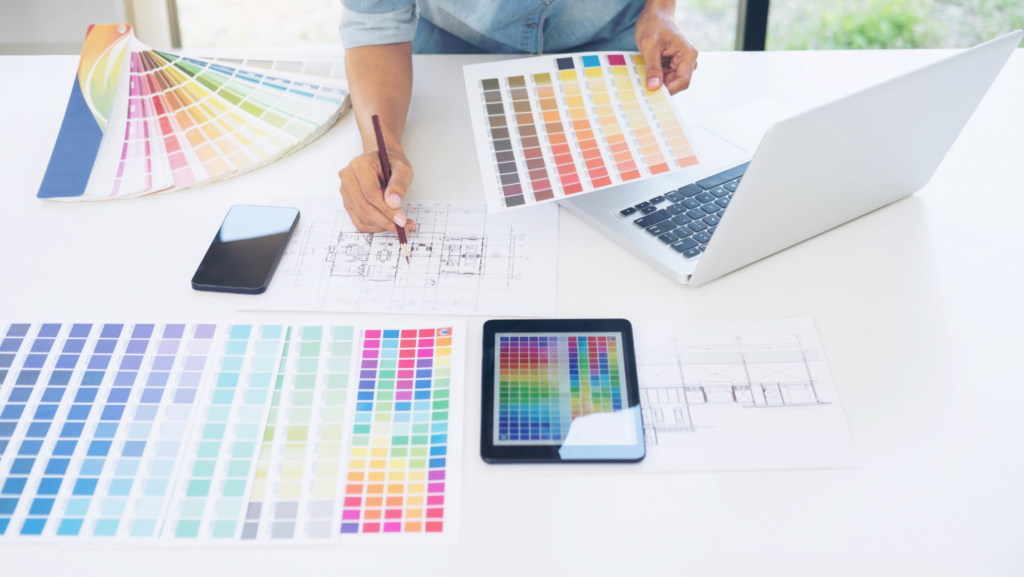Digital design and animation have revolutionized the way we experience visual storytelling. From blockbuster movies to mobile apps, these creative disciplines shape our daily digital interactions. What was once limited to simple stick figures has evolved into stunning 3D worlds that blur the line between reality and imagination.
Today’s digital artists wield powerful tools to bring their wildest ideas to life. Whether it’s crafting eye-catching marketing materials or developing immersive video game environments, the possibilities seem endless. The fusion of artistic vision and technical expertise has created a booming industry that’s expected to reach $270 billion by 2025 – proving that creativity and technology make quite the power couple in our modern world.
Digital Design and Animation
 Digital design and animation combines artistic creativity with technical expertise to create visual content through computer software. This field integrates traditional design principles with modern digital tools to produce dynamic visuals for various media platforms.
Digital design and animation combines artistic creativity with technical expertise to create visual content through computer software. This field integrates traditional design principles with modern digital tools to produce dynamic visuals for various media platforms.
Digital design and animation incorporates five fundamental elements: color theory, typography, motion principles, composition rules and visual hierarchy. Color theory guides emotional responses through strategic use of color palettes in designs. Typography selection impacts readability and brand messaging across digital platforms. Motion principles like timing, spacing and acceleration create fluid animated sequences. Composition rules determine visual balance through layout structures and negative space. Visual hierarchy directs viewer attention using size, contrast and positioning of design elements.
Industry Applications
Digital design and animation powers content creation across multiple sectors. Entertainment studios utilize 3D animation for feature films, television shows and video game development. Marketing agencies create motion graphics for social media campaigns, product demonstrations and brand videos. Educational institutions implement animated content for e-learning modules and interactive training programs. Healthcare organizations use medical animations to explain procedures and biological processes. Architectural firms create 3D visualizations for building proposals and virtual property tours. The manufacturing sector employs technical animations for product assembly guides and maintenance instructions.
Essential Software Tools for Digital Design
 Digital design professionals rely on specialized software tools to bring their creative visions to life. These tools range from industry-standard applications to emerging platforms that cater to specific design needs.
Digital design professionals rely on specialized software tools to bring their creative visions to life. These tools range from industry-standard applications to emerging platforms that cater to specific design needs.
Adobe Creative Suite leads the 2D design software market with three core applications. Adobe Photoshop excels in image manipulation raster graphics with features like layer masks brushes filters. Adobe Illustrator creates vector graphics logos illustrations scalable artwork. Adobe After Effects produces motion graphics visual effects 2D animation.
Alternative options include Affinity Designer offering professional vector tools at a lower price point. Sketch dominates UI/UX design on Mac systems through its intuitive interface prototyping capabilities. Figma enables real-time collaboration browser-based design making it ideal for remote teams.
3D Animation Programs
Autodesk Maya stands as the industry standard for 3D animation in film television gaming. Cinema 4D appeals to motion designers through its user-friendly interface MoGraph toolset. Blender provides a free open-source alternative with professional-grade features including modeling rigging rendering.
ZBrush specializes in digital sculpting high-resolution model creation for characters objects. Houdini excels in procedural modeling visual effects with node-based workflows. 3ds Max delivers comprehensive tools for architectural visualization game development product design.
| Software Type | Popular Options | Primary Use Cases |
|---|---|---|
| 2D Design | Adobe Suite, Affinity, Sketch | Graphics, UI/UX, Vector Art |
| 3D Animation | Maya, Cinema 4D, Blender | Films, Games, VFX |
The Digital Design Process
Digital design encompasses a systematic workflow that transforms conceptual ideas into polished visual content. Each phase integrates creative decisions with technical implementation to produce cohesive digital experiences.
Pre-Production Planning
Pre-production planning establishes the foundation for digital design projects through comprehensive research analysis. The process starts with mood boards collecting visual references typography samples color palettes design trends. Project timelines outline key milestones deliverables resource allocation technical requirements. Storyboards map the visual narrative frame by frame detailing camera movements transitions character interactions. Target audience analysis shapes design decisions through demographic data user preferences behavioral patterns. Budget considerations determine software choices equipment needs team composition production scale.
Creating Assets and Elements
Asset creation forms the core phase of digital design through the development of visual elements. Artists generate vector graphics raster images 3D models UI components based on approved concepts. Character designers craft detailed models with specific attributes expressions movement capabilities. Environmental artists build digital landscapes props lighting setups atmospheric effects. Motion graphic designers prepare animated elements title sequences transitions visual effects. Technical artists optimize assets for different platforms file formats performance requirements.
Adding Motion and Effects
Motion design transforms static elements into dynamic experiences through calculated animation techniques. Animators apply principles like timing spacing acceleration deceleration to create natural movement. Effects artists integrate particle systems dynamic simulations procedural animations environmental effects. Compositors blend multiple layers adding depth lighting color corrections visual enhancements. Real-time preview tools enable immediate feedback adjustments refinements throughout the animation process. Motion tracking stabilization tools ensure smooth camera movements precise object interactions.
Current Trends in Digital Animation
Digital animation continues to evolve with technological advancements, transforming how creators produce engaging visual content. The integration of cutting-edge technologies enables more immersive experiences while streamlining production workflows.
Real-Time Rendering
Real-time rendering revolutionizes animation production by generating high-quality visuals instantaneously. Game engines like Unreal Engine 5 empower creators to visualize complex scenes immediately, eliminating lengthy render times. Studios leverage this technology for virtual production, creating dynamic backgrounds on LED walls during live filming. Real-time rendering enables interactive previews of character animations, lighting adjustments, and environmental effects. Major animation studios implement this technology to reduce production costs by 40% while maintaining cinematic quality. The automotive industry utilizes real-time rendering for interactive vehicle configurators, allowing customers to visualize customizations instantly.
Virtual Reality Integration
VR technology transforms digital animation through immersive 3D environments. Animators use VR tools like Quill and AnimVR to create expressive animations directly in virtual space. Leading animation studios adopt VR platforms for storyboarding, reducing pre-production time by 30%. The technology enables artists to manipulate 3D models intuitively through natural hand movements. VR animation software features precise motion tracking capabilities for character animation. Entertainment companies integrate VR animation in theme park experiences, educational content, and interactive storytelling. Motion capture systems combined with VR create realistic character movements in real-time. Animation schools incorporate VR training programs to prepare students for emerging industry demands.
Career Opportunities in Digital Design
The digital design industry offers diverse career paths with competitive salaries ranging from $45,000 to $150,000 annually. Employment opportunities in this sector continue to expand at a rate of 16% annually, driven by increasing demand across multiple industries.
Required Skills and Education
Digital design professionals combine technical proficiency with creative abilities to succeed in the field. A bachelor’s degree in Digital Arts, Animation, Graphic Design, or a related field provides essential foundational knowledge. Technical skills include mastery of industry-standard software such as Adobe Creative Suite, Autodesk Maya or Cinema 4D. Core competencies encompass:
- Visual design principles including color theory typography composition
- Programming languages like HTML CSS JavaScript for interactive designs
- 3D modeling texturing rigging animation techniques
- Project management collaboration communication abilities
- Problem-solving analytical thinking skills
Top Industry Roles
Digital design professionals fill specialized positions across various sectors. Salary ranges reflect experience level market demand location:
| Role | Average Salary | Growth Rate |
|---|---|---|
| Motion Designer | $72,000 | 14% |
| 3D Animator | $78,000 | 16% |
| UI/UX Designer | $85,000 | 18% |
| Art Director | $95,000 | 12% |
| Creative Director | $120,000 | 10% |
Leading employers include entertainment studios gaming companies advertising agencies tech firms educational institutions. Remote work opportunities have expanded significantly with 45% of digital design positions offering flexible arrangements.
Future of Digital Design and Animation
Digital design and animation continue to evolve with groundbreaking technologies enabling unprecedented creative possibilities. The integration of artificial intelligence and cloud computing transforms the landscape of digital creation.
Emerging Technologies
Artificial intelligence algorithms now automate complex animation tasks through machine learning models that analyze movement patterns and generate realistic animations. Cloud-based rendering services process high-quality animations 5x faster than traditional methods, enabling real-time collaboration across global teams. Advanced motion capture systems utilize neural networks to translate human movements into digital characters with 99% accuracy. Blockchain technology creates new opportunities for digital artists through NFTs, with the market reaching $2.5 billion in 2023. Quantum computing developments promise to revolutionize rendering capabilities, potentially reducing processing times by 100x for complex animations.
New Creative Possibilities
Extended reality (XR) platforms enable artists to create immersive 3D environments with direct manipulation in virtual space. Digital artists leverage procedural generation tools to produce diverse landscapes across multiple projects, saving 70% of production time. Neural networks generate dynamic textures based on artistic parameters, expanding creative options for designers. Holographic displays present animations in volumetric space, creating engaging experiences without special eyewear. Cross-platform development frameworks allow seamless content adaptation across devices, reaching 85% more viewers. Real-time ray tracing technology produces photorealistic animations with accurate lighting effects in half the traditional rendering time.
Digital design and animation stands at the forefront of creative innovation revolutionizing how we communicate visually. The field’s rapid evolution continues to shape entertainment media education and business communications through powerful software tools and emerging technologies.
As AI virtual reality and cloud computing advance the possibilities for digital creators seem limitless. The industry offers exciting career opportunities with competitive salaries and flexible work arrangements making it an attractive path for creative professionals.
The fusion of artistic vision and cutting-edge technology promises to drive even more groundbreaking developments. From immersive entertainment to educational content digital design and animation will remain essential in shaping how we experience and interact with visual media in the years ahead.

